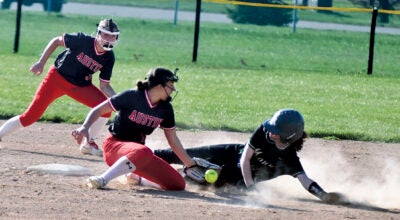50 states, 50 heroes: Silencing the guns
Published 7:01 am Saturday, May 9, 2020
|
Getting your Trinity Audio player ready...
|
Born on Oct. 2, 1918, in Portland, Maine, Charles Joseph Loring Jr. enlisted in the U.S. Army Air Corps in 1942. After completing flight training at Maxwell Air Force Base in Montgomery, Alabama, Loring was commissioned a second lieutenant and assigned to the 22nd Fighter Squadron of the 36th Fighter Group, Ninth Air Force in Puerto Rico. There Loring flew anti-submarine patrols as part of the defense of the Caribbean Sea and Panama Canal Zone. Loring’s unit later moved to South Carolina and trained to fly P-47 Thunderbolts. In April 1944, they were deployed to Kent, England, to conduct missions against German targets.
Loring participated in the preparation of the June 6, 1944, D-Day attack by attacking German strong points throughout Northern France. During an air support mission on June 12 near Coutances, France, Loring earned the Distinguished Flying Cross after destroying 10 enemy armored vehicles while under heavy fire.
Loring had 55 missions under his belt when his Thunderbolt was shot down over Belgium during the Battle of the Bulge on Dec. 24, 1944. He was captured and sent to a German prisoner of war camp, where he was held until the camp’s liberation on May 5, 1945.
After World War II, Loring remained in the U.S. Army Air Corps (which became the U.S. Air Force in 1947) and was promoted to captain. At the outbreak of the Korean War in 1950, Loring was serving as a flight instructor. He continued in that role until 1952, when he returned to combat.
While in Korea, Loring flew missions with the 36th and 80th Fighter-Bomber Squadrons. By November 1952, he had flown 50 missions in a F-80 Shooting Star and was promoted to major.
At this point, the Korean War had reached a stalemate as fighting continued along the 38th Parallel. UN forces launched an offensive against Chinese and North Korean forces at two points known as Triangle Hill and Sniper Ridge, located in Kimhwa County, North Korea, about 20 miles north of the 38th Parallel. The combined communist forces had amassed 133 artillery pieces, 24 rocket launchers and 47 anti-aircraft guns and launched the largest communist artillery operation of the war.
On Nov. 22, 1952, Loring was on patrol in the area when he received word from an American scout plane that an enemy artillery battery was pinning down UN forces near Sniper Ridge. Furthermore, the communist forces had multiple anti-aircraft guns surrounding the battery. Leading four other F-80s of the 80th Fighter-Bomber Squadron, Loring ordered his men to attack the enemy position.
When Loring and his men reached the target site, the well-trained anti-aircraft crews targeted Loring’s plane, directing accurate and devastating fire that disabled the fighter. Loring’s men, who were further back, suggested that he abort the mission. Instead, Loring ceased radio communications and proceeded on what looked like a normal bombing run. But as Loring reached 4,000 feet, he turned his F-80 45 degrees and aimed it directly at the enemy battery. Loring’s stunned men watched as his plane accelerated and crashed into the enemy guns, completely destroying the battery.
Loring’s remains were never recovered and he was declared “Missing in action, presumed dead.” A marker stands in his memory in Arlington National Cemetery.
On May 5, 1954, President Dwight Eisenhower posthumously awarded Loring the Medal of Honor, which was presented to his wife, Elsie Loring. Eisenhower then announced that the newly built Air Force base in Loring’s home state of Maine would be named Loring Air Force Base in his honor.
Loring Memorial Park in Portland is also named in his honor.


